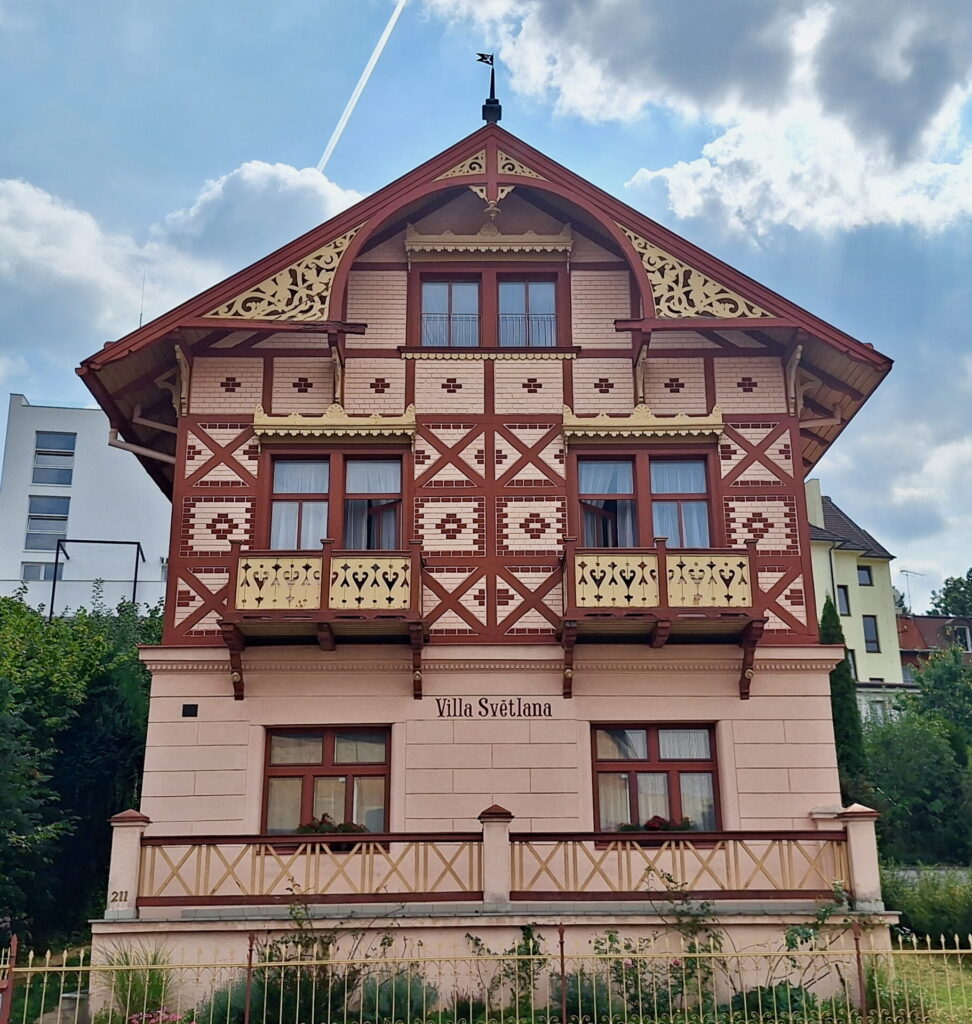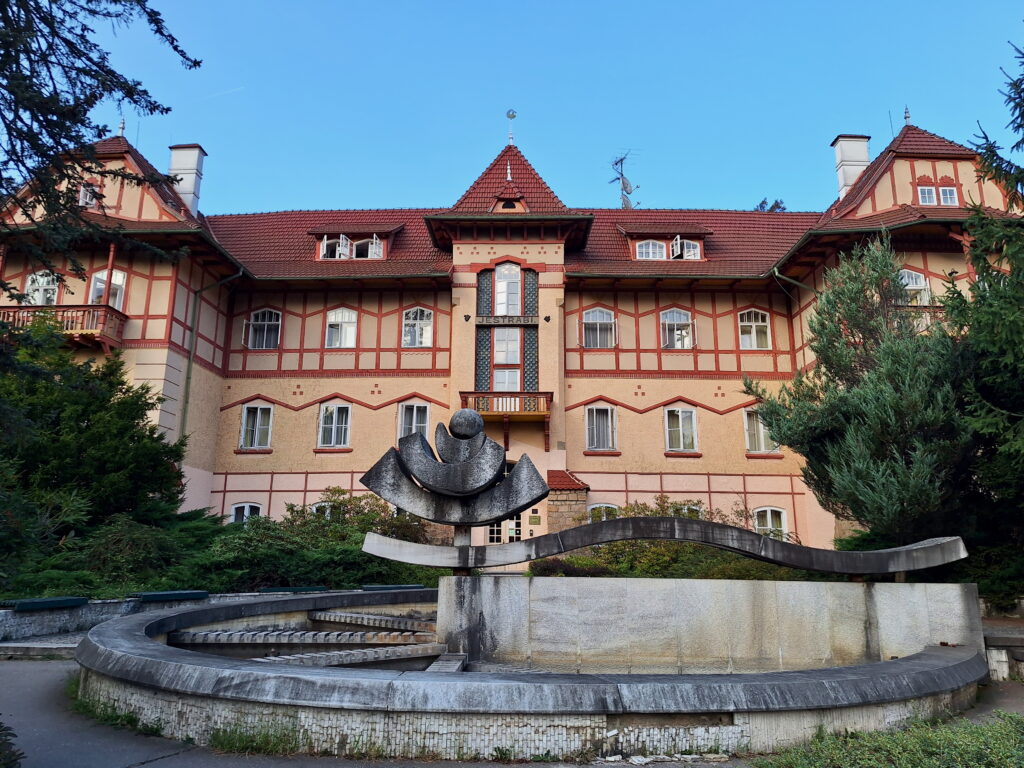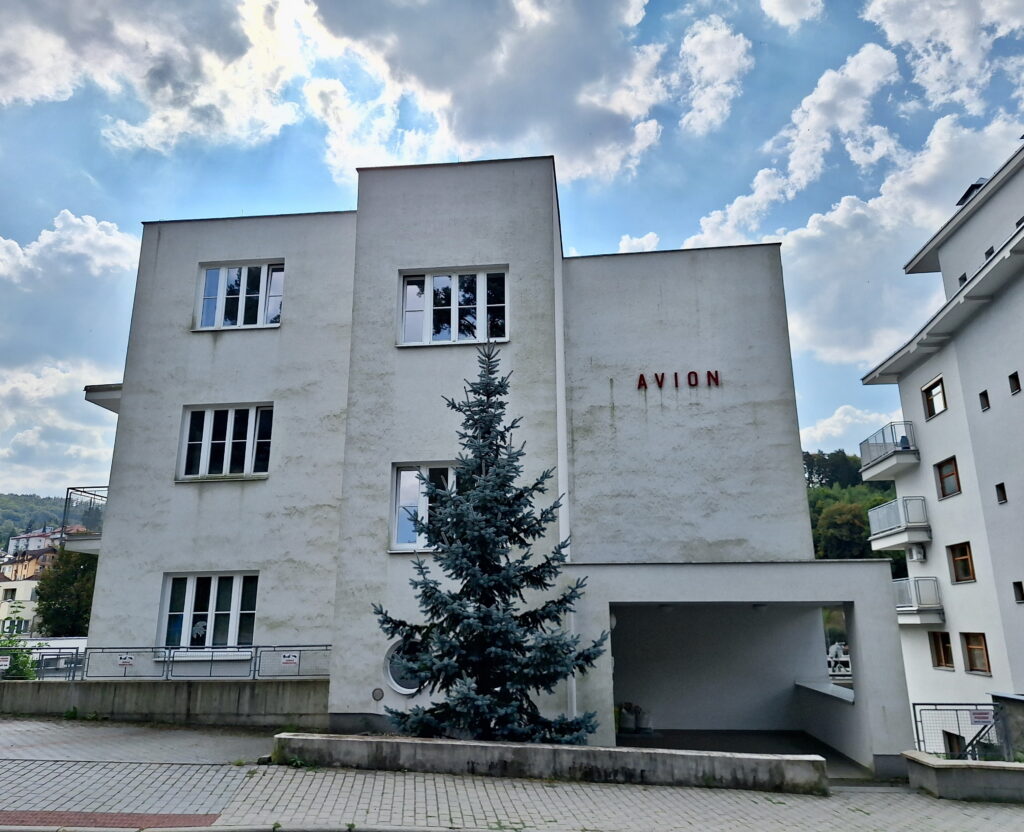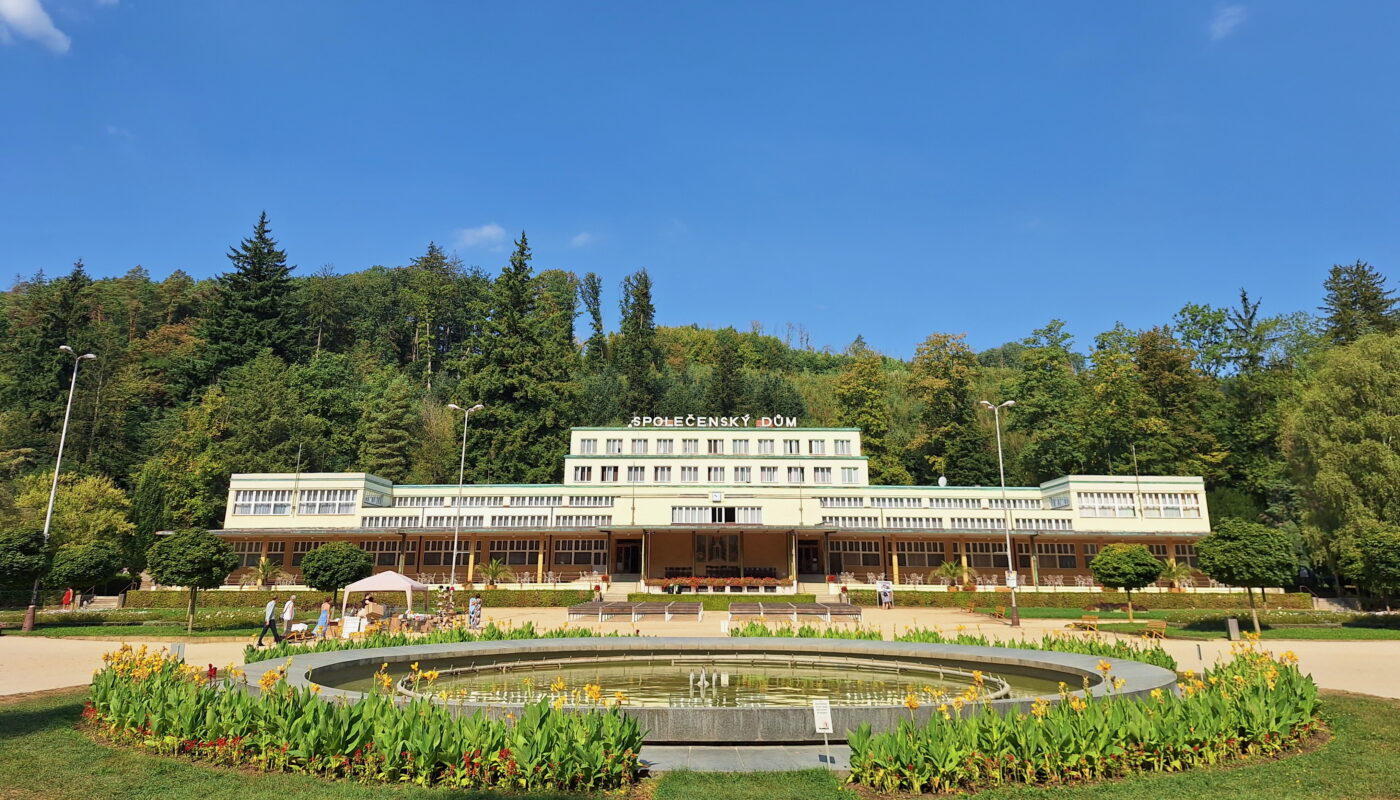Reading Time: 3 Minutes 59 Seconds
General and historical info
In this article, I will make a long list with the architectural sights of Luhačovice, with some short info or digression about history and other topics.
The town of Luhačovice lies in the famous Slovácko region, or more precisely in the Luhačovice Zálesí (the Luhačovice forest), in South-East Moravia, at the border with Slovakia.
It is not clear when the first spring were discovered, however, it is known that by the late 18th century, many people were visiting the spa town to get treated with the local mineral water.
To accommodate the arrival of so many guests, the development of houses and other lodging began.
The construction activity went on for a hundred years and by the beginning of the 20th century there were a chapel, a castle, several hotels and inns, as well as a brand new railway station.
Direct trains connecting Prague, Brno and Olomouc to Luhačovice were running in 1905.
During the first years of the 20th century, the Slovak architect Dušan Jurkovič, known as the poet of the wood (básnik dreva), was responsible the construction of several buildings, many of which are still visible today.
Jurkovič’s style is referred to as Folk Art Nouveau, because it incorporates flowing and curvilinear motifs inspired by plants and nature (as in Art Nouveau), but realized mostly in wood, and integrates to it elements of the local folklore (Moravian and Slovak).
Luhačovice was shaped by Jurkovič’s art, and today his association with the spa town is indelible.
The town extends longitudinally from the castle and train station at the Southwest to the artificial lake and its dam at the North east.
Let’s say that the main architectural attractions are condensed in the pedestrian area located between the Luhačovický stream (colloquially called Šťávnice) and the main road.
However, if you are curious and have more time at your disposal, there is plenty of other things to do and see.
Architectural gems of Luhačovice
Starting from the entrance to the town at the Southern side and moving along the main path, you come across the buildings listed below. The last section relates to the other side of the stream, on the way back.
- On the main road (Masarykova) there is villa Radhošť, a spa pavilion in Art Nouveau. The facade is interesting, because of a statue of Atlante holding a window bay.
- Further ahead there is a huge building from the 1980s. It works as info centre, museum of local culture and folklore, art gallery, culture and congress centre, with annexed restaurant.
- Right in front of the info centre are the 2 villas Světlana (from 1899) and Haná (from 1887) in Art Nouveau Swiss-style.

- Continuing on Masarykova street, on the right side you find the Alexandria spa hotel, in whose restaurant you can enjoy tasty local cuisine with a live piano in background.
In addition, even if you are not a hotel guest, you can join their breakfast buffets (open to public for ~300kč), where you can have a proper brunch, with a lot of different food, including pancakes baked on the spot and prosecco.
The pedestrian area
- Entering the pedestrian area, you immediately see the Funcionalistic building of the post office.
- Moving ahead, you find the theatre, which looks abandoned, even if it is still in operation.
- Few steps forward, on the left side, there is the inhalatorium (working as of today), with Art Deco details and gargoyles.
- On the right side stands the theatre restaurant and café, a recently renovated Functionalist building, that stands on the premises of the wooden diary originally planned by Jurkovič.
- Soon after, you find the “Kavárna v Myslivně” (café at the hunting house), with angled roof and wooden balconies, that recalls the style of the Alpine spa towns.
You can stop here for home-made cakes. - Behind the café stands the hotel Villa Chaloupka, built by Jurkovič at his own expenses.
- Returning on the main path, you encounter the Chapel of Saint Elizabeth, which is the oldest construction of the spa, dating 1795.
- In front of the chapel stands the spa hotel Jurkovič’s house (Jurkovičův dům), in Art Nouveau, which is the most famous and most precious building in the whole town.
The colonnade and the Vincentka spring
- Between the chapel and Jurkovičův dům, begins the Colonnade (kolonáda), built in 1945-1950. It spans 130m and reaches the Vincentka spring hall.
The hall is open every day from 8:00 to 20:00 throughout the year, and you there can taste the mineral water for free in its cold and warm variants. Just bring a glass or a bottle with you or pay 20kč for a disposable paper cup from the dispenser on-site.
Vincentka is a unique mineral water that has been used since the 17th century.
At that time, the water source was simply called “the main spring” (hlavní pramen). In the 18th century it was renamed “Vincentka” in honor Count Vincenc Serényi, a member of the Hungarian aristocratic family Serényi von Kis-Serény, who lived in Moravia and owned the spa town during that period.
The water is still used today as drinking treatment and for inhalations to cure respiratory and metabolic diseases, and for stomach problems.
The mineral water Vincentka is also bottled, and it is on sale practically everywhere. You will find it in supermarkets around the whole Czech Republic.
The northern side
- Continuing the walk further, you cross the Luhačovický stream to reach hotel Jestřabí, another Art Nouveau villa by Jurkovič. Its symmetrical structure both symbolically and physically marks the closure of the spa valley.
In a side area of the villa there is supposed to be a Japanese garden, but its state depends on the season you are visiting.

- On the right side of the Jestřabí, crossing the road, you find the Luhačovice Sun Spa (Sluneční lázně), another building that carries Jurkovič’s signature.
The site was historically used for hydrotherapy and sun baths.
After its restoration, completed in 2023, it reopened as a museum and exhibition space.
Inside there is an area that illustrates the history of the Sun spa and hydrotherapy, and another section is dedicated to the Czech composer Leoš Janáček, who was a frequent visitor of the spa town. You can also admire replicas of the original furniture.
In the immediate vicinity of the spa main building there is an ornamental biotope, which in old times served as a public swimming pool, fed by the water of the Šťávnice.
You can still see the old wooden cabins that were used by the spa guests to change their clothes before proceeding with the water and sun bathing.
- If you peek a bit more, behind the Sun spa you see the Socialist building of the Central spa.
- Returning to the pedestrian area, on the left side of the Jestřabí and of the Luhačovický stream, there is a wooden gazebo hidden by trees.
Originally it was intended for the spa orchestra, which played there every day. Nowadays it is not much taken care of.
Oh, I forgot to say that this gazebo is from Jurkovič too.
Over the Luhačovický stream
- Walking back along the promenade, keep the left side of the stream and you see two buildings very close to each other. They are both from the Czech architect Emil Králík, even if their styles are in contraposition.
The first structure is the so-called “House of Bedřich Smetana“, an amazing Art Nouveau villa, built in 1909, with Cubist elements and ceramic tiles.
The second building is the Spa directorate, built in 1928, in a pretty clean and austere style, especially if compared to the adjacent villa. - Soon after we find the Funcionalist “Common house” (Společenský dům), which stands directly across from the kolonáda.
It represented, and still represents the main building for the social events of the town.
The house still provides its original services: restaurants, library, bar, hall with dance floor, accommodation for guests (a quite basic one), and an outdoor stage during summer months.
The interiors are mostly original and you can go have a peek. - On the side of the house are Villa Růžová (the pink villa, which is light blue instead), Villa Lipová, and the wooden pavilion at the tennis court.
This last one looks like a Jurkovič production, but is it from architect Josef Skřivánek.
The main spa area ends here.
The white neighborhood
You can also explore the “White Neighborhood,” named for its three white Functionalist villas designed by the renowned architect Bohuslav Fuchs, which were built between 1927 and 1928. Alongside the villas, an open-air swimming pool was also built on the site.

The three villas – Avion, Viola, and Radun were originally designed to accommodate guests of the spa town.
However, during the war, they got confiscated along with many other buildings in the town and the country.
After the war, the villas were nationalized, and their structures, particularly the interiors, were modified.
Later, architect Viktor Janda added three more villas in the “Poetic Functionalism” style, commissioned by investors from Zlín. These villas – Draža, Eva, and Jarča – share a similar design but differ in their facades and entrances, giving each a unique appearance.
Draža features a more geometric and Art Deco facade, Eva has a semicircular portico entrance, and Jarča is characterized by its simplicity and linear design.
Unfortunately, the families who owned the villas did not reside there for long due to the war. The restitution process began in 1992, allowing descendants to reclaim the villas, with Draža being returned only in 2012.
Today, the last three villas are no longer white and all of them have been transformed into spa hotels. The original swimming pool was closed in the early 2000s, and a new one, covered by a roof yet still respecting Fuchs’s Functionalist principles, began operating in 2010.
Other activities
If you are interested in exploring further, you can consider other villas from Jurkovič, such as Villa Valaška and Villa Vlastimila.
Alternatively, take a stroll in the parks that surround Luhačovice or head to the dam, where you find an artificial lake and beach.
The area around the dam is used in spring and summer for recreational activities.
On the shore of the artificial lake there are two beaches, a camping site, a swimming pool with water slides, restaurants and refreshment kiosks, and a pier, where you can rent tiny boats and pedalo.
There are numerous hiking trails in the area, especially since the natural reserve of the White Carpathians (Bílé Karpaty) has one of its borders here in Luhačovice.
The trails are marked with various colors, and you can find them either on mapy.cz or you can ask for a paper map at the info centre.
Some of the shorter trails lead to different water springs in the forest, for example to Aloiska, Viola, Ottovka, or Marie.
One of the most popular route is the 17km Dušan Jurkovič’s loop.

